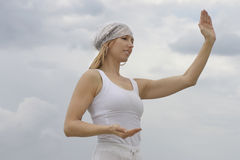Harvard medical professionals have been studying the benefits of tai chi, and the results are worth noting and incorporating into your exercise regimen.
Peter Wayne—medical director of Harvard Medical School’s Introduction to Tai Chi—has discovered, along with his research team, that tai chi benefits participants in a variety of ways, like a “multi-drug combination.”
Wayne devised what he calls the “eight active ingredients” of tai chi, which he and his colleagues now use as a conceptual framework in evaluating tai chi’s benefits, a way to explore the underlying mechanisms that provide these effects, and for shaping the way tai chi is taught to both the clinical trail participants and teachers.
Each different tai chi style stresses different ingredients, but these therapeutic ingredients are interwoven and symbiotic—they work in combination and compliment one another. And complete one another, like two perfectly-timed and orchestrated ballroom dancers.
Critical tai chi components—
Rather than focus on one body part—like doing bicep curls to increase bicep strength and tone or squats to tighten your glutes —tai chi movements look at the body (and rightly so) as an interconnected system. Upper body to lower body connectedness; right side to left; and the limbs with the body’s core.
I can appreciate this whole-body interconnectedness.
As a gymnast, my entire body functioned as an interconnected unit—when I made foot or hand contact with the ground or when airborne. One false move, and the rest of the body follows suit, usually to a splat on the mat.
When I handed in my leotard for a teeny bikini and oil-slicked body for body building competition, I noticed big body coordination changes.
Yes, I was incredibly toned, strong and buffed up, but my ability to move gracefully, multi-directionally, and smoothly plummeted. It was clear that the one-directional (single plane) exercise structure of weight lifting wasn’t benefitting my body’s connectedness and fluidity. (See the grainy snapshot below of me in the Palm Springs Classic many moons ago.)
I decided to retire my signature royal blue bikini.
And for those of you old enough to remember, a popular NFL player started taking ballet classes to improve his dexterity, litheness and body control on the football field. People razzed him to no end about it, but today a number of 300-pounders take ballet lessons to improve their football form. And they say it’s the hardest activity they do! (Yes, ballet is much more difficult than football.)
Tai chi focuses—
Alignment and posture are critical components. Tai chi teaches you to move in safe, unstrained alignments. And this integration promotes graceful movements that extend beyond the tai chi session to your daily life.
The result?
Less stress and load on your joints, and improved balance. A win-win situation all around, especially for aging seniors who spend too much time sitting in recliners watching television and losing their balance and strength.
Added bonus from doing tai chi—
If being able to move without pain weren’t enough, tai chi boasts another bonus: improved mental health.
Interestingly, shoulder slouchers tend to have a more negative outlook on life. Upright walkers more positive.
Maybe tai chi helps contribute to your feeling active, a benefit we talked about here on a Meditation Mondays installment.
 Anyone out there a tai chi devotee? I’d love to hear your experience with this activity. I just purchased Wayne’s Introduction to Tai Chi. Can’t wait for it to arrive so I can have one more tool in my graceful aging toolkit! Wayne is also the author of Harvard Medical School Guide to Tai Chi.
Anyone out there a tai chi devotee? I’d love to hear your experience with this activity. I just purchased Wayne’s Introduction to Tai Chi. Can’t wait for it to arrive so I can have one more tool in my graceful aging toolkit! Wayne is also the author of Harvard Medical School Guide to Tai Chi.
Until next week, branch out, think integrated movement, and pick a activities that strengthen, coordinate and balance your body.
Blessings,
Andrea
Andrea Arthur Owan is an award-winning inspirational writer, fitness pro and chaplain. She writes and works to help people live their best lives—physically, emotionally, and spiritually.
